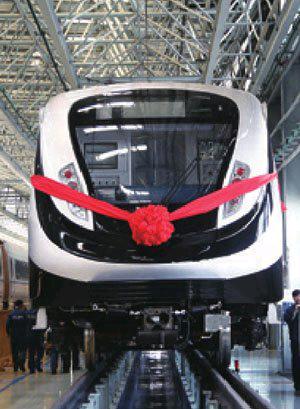Smiling Sailors
2015-06-05
Chinese and Russian sailors take a group photo on May 20 after joint military exercises in the Mediterranean.
The Joint Sea-2015 drills—involving six Russian and three Chinese ships—were staged in four phases, focusing on maritime defense, replenishment and escorting. It was the fourth since joint China-Russia sea drills began in 2012.
State Compensation
Chinas Supreme Peoples Court (SPC) has increased the compensation standard for citizens whose freedom has been infringed upon by the state.
The new standard has been set at 219.72 yuan ($35.46) per day, up 19.03 yuan ($3.07) from the 2014 level, according to a statement published by the SPC on May 27.
The adjustment was based on the increase in the average salary of state employees in 2014, which stood at 57,346 yuan ($9,250) in 2014.
According to Chinas law on state compensation, the reparation for loss of personal freedom shall be calculated according to the average daily salary of state employees in the preceding year.
Medical Data Center
China established a national medical data center in Peking University on May 26 to improve health services and administration through state-of-the-art analysis.
The center was co-founded by the National Health and Family Planning Commission and Peking University.
Peking University has gathered 48 million items of clinical data from more than 400 hospitals across the country, according to Zhang Jun, head of the universitys Hospital Administration Department.
Experts on clinical medicine, information, epidemiology and computer science will work together to process and manage the data to improve the efficiency of healthcare, Zhang said.
Geo-Database Update
China has solved a major scientific conundrum by updating geographic information of the worlds third largest country in terms of land area.
The National Administration of Surveying, Mapping and Geoinformation announced on May 22 the completion of the 2014 version of Chinas geo-database, meaning all data is accurate up to last year.
The updated database, encompassing 24,000 pictures, shows that China had about 6,000-km railways, 7,000-km highways, 34,000-km national or provincial expressways and 138,000-km county roads added to the existing transportation network in 2014.
About 9,000 square km of urban blocks were created last year with 9,000-km new power lines. More than 830,000 geographical names were changed and 350,000 place names were created.
The database will be used for irrigation projects, transportation, land, agriculture, forestry, environment, rural and urban planning and national defense, the administration said.
Modernized Farming
Chinas Ministry of Agriculture on May 27 published a set of guidelines for achieving no discharge of agricultural waste by 2030.
The guidelines set targets on agricultural science and mechanization. According to the document, China must guarantee maintaining no less than 104 million hectares of farmland by 2020. The country also aims to increase its forest coverage rate to 23 percent in the same period.
Annual water consumption for irrigation should not exceed 372 billion cubic meters, while the utilization rate of irrigation water should rise to 55 percent, compared to 50 percent now. One cubic meter of water only produces 1 kg of grain harvested in China, lower than the average of 1.2-1.4 kg in advanced countries.
The guidelines also urged farmers to reduce the use of chemical fertilizers and pesticides by limiting waste and switching to organic alternatives.
Songs for Olympic Bid
Beijing released 10 songs for its 2022 Winter Olympics bid on May 27, aiming to further promote Olympic Spirit and kindle Winter Olympics enthusiasm among Chinese citizens.
The song selection was initiated last August and more than 60 songs had been received.
The International Olympic Committee will vote on Beijings bid against Almaty, Kazakhstan, on July 31 in Kuala Lumpur, Malaysia.
Support for Talent
The Chinese Academy of Sciences (CAS) will launch a new program to attract and support urgently needed scientists, according to an announcement on May 25.
Titled New 100-Talent, the program aims to attract 100 scientists worldwide, who are urgently needed in cuttingedge fields in China and have the potential to make international breakthroughs, according to the CAS.
The program will offer financial subsidies and support staff to the leading figures who have achieved innovation so that they can continue to yield new findings in science and help cultivate young research fellows.
Young scientists under the age of 35 with outstanding potential in research will also be covered by the program.
A program to cultivate innovative personnel launched by the CAS in 2009 has so far brought in more than 2,300 high-caliber scientists from overseas and nurtured more than 3,500 young researchers.
Flood Control
Xinjiang Uygur Autonomous Region in northwest China will launch a flood control project along the Yarkant River, according to regional authorities.
The project is expected to cost 2.9 billion yuan ($468 million) and take three years to complete.
The Yarkant River frequently floods along nearly all of its 1,289-km length. Disaster relief amounts to multi-million yuan in each flood season, with 90 percent of residents living on its banks needing to be taken care of.
The project will have dykes newly constructed or reinforced, river way dredged and floodgates reconstructed.
Fruits of Labor
Lu Xianping works in a lab at the Shenzhen Chipscreen Biosciences Ltd. in Shenzhen, south Chinas Guangdong Province, on May 20.
Lu, together with other four returned overseas scientists, spent 14 years to develop Chidamide, the worlds first oral HDAC inhibitor, which was given regulatory approval for the Chinese market in January.
Space Power
Chinas space capabilities are ranked the fourth in the world, and the gap between the leading powers is narrowing, according to an evaluation by the Beijing Institute of Space Science and Technology Information, affiliated to the China Academy of Space Technology.
Last year saw a record 92 launches around the world, with 262 spacecraft put into orbit. The institute for the first time evaluated the space capabilities of 20 countries and regions. It rated the United States, Europe, Russia, China, Japan and India as the leading powers in space.
Pursuing an independent development path, China has made remarkable accomplishments in space technology, showing strong momentum and potential, the report commented.
Festival Frocks
Exquisitely costumed women from Miao ethnic group in southwest Chinas Guizhou Province are on their way to take part in a celebration of the traditional Si Yue Ba festival, which falls on May 25.
Good as Gold
A gold sector fund involving countries along the ancient Silk Road was set up in the northwest Chinese city of Xian on May 23.
The fund, led by Shanghai Gold Exchange, is expected to raise an estimated 100 billion yuan ($16.1 billion) in three phases.
China is the worlds largest gold producer, and also a major importer and consumer of gold. Among the countries along the proposed Silk Road Economic Belt and the 21st-Century Maritime Silk Road, there are many Asian countries identified as important reserve bases and consumers of gold.
About 60 countries have invested in the fund, which will in turn facilitate gold purchases for the central banks of member states to increase their holdings of the precious metal, according to the Shanghai Gold Exchange.
“China does not have a big say in gold pricing because it accounts for a small share of international gold trade,”said Tang Xisheng of the Industrial Fund Management Co. “Therefore, the Chinese Government seeks to increase the influence of the yuan in gold pricing by opening the domestic gold market to international investors.”
According to Tang, the fund will invest in gold mining in countries along the ancient Silk Road, which will increase exploration in countries such as Afghanistan and Kazakhstan.
New Area
Changsha, capital of Hunan Province, established central Chinas first statelevel new area on May 24 to try out economic and administrative reform measures.
Xiangjiang New Area, which was given the green light by the Central Government in April, sits on the west bank of the Xiangjiang River and covers 490 square km across several districts in Changsha.
It will pilot 10 major reform measures in areas including government administration, economics, environmental protection and rural-urban integration, according to the Changsha Municipal Government.
It will be Chinas 12th state-level new area since Shanghais Pudong New Area was launched in 1992, followed by other such areas in cities and provinces including Tianjin, Chongqing, and Zhejiang, Gansu and Guangdong provinces. China uses these areas to test reforms, pilot opening-up policies and test other measures.
A statement by the Central Government said it wanted to build the Xiangjiang New Area into a hi-tech manufacturing and innovation base to aid the development of central China and the Yangtze River economic belt.
Big Future
Attendees of the Guiyang International Big Data Expo 2015 sign the Big Data Guiyang Declaration on May 26.
The expo kicked off in Guiyang, capital of southwest Chinas Guizhou Province, on May 26. The three-day event attracted experts and businesses from home and abroad to discuss the future of big data.
Infrastructure Loan
Chinas Ministry of Finance said on May 27 that it had concluded negotiations with the Asian Development Bank (ADB) on projects in western border counties in Xinjiang Uygur Autonomous Region.
The ADB will offer a loan of $150 million, more than one half of the total 1.73 billion yuan ($282.53 million) needed for the projects, a statement on the ministrys website showed.
The rest of the investment will be covered by local governments, according to the statement.
Located in Tacheng and the counties of Emin, Tuoli and Yumin, the projects include bridges, roads, heat supply, water supply and drainage pipeline networks.
The projects aim to upgrade infrastructure in the far west of China while promoting economic development and social stability there, said the statement.
Funding West China
The National Development and Reform Commission (NDRC) issued a guideline on May 23, promising it will continue to direct capital to the countrys western areas this year.
The guideline announced that 100 million yuan ($16.36 million) has been allocated to boost development in 12 provinces and autonomous regions in west China.
The NDRC started ejecting capital into the area in 2012 and has allocated 100 million yuan every year in the central investment budget to the large but less developed western region.
The money will improve peoples lives by accelerating infrastructure and environment programs, including transprovincial railways and water diversion projects, resulting in a solid basis for further investment and economic growth, the NDRC said.
Mission Accomplished
A subway train to be used for the 2016 Olympic Games in Rio de Janeiro rolls off the production line at the Changchun Railway Vehicles Co. Ltd. of CNR in Changchun, capital of northeast Chinas Jilin Province.
On May 25, China delivered all the subway trains that will operate during the Games in Rio de Janeiro. The body of train is specially designed to cope with local humidity and special air conditioners have been installed inside the train to deal with high temperature.
Internet Bank Approved
China approved the opening of Alibaba-backed Internet bank MYbank on May 27, in the latest development of a pilot program to bring in private players in the state-dominated sector. MYbank, mainly funded by Zhejiang Ant Small and Micro Financial Services Co. owned by Alibaba Chairman Jack Ma and his colleagues, has a registered capital of 4 billion yuan ($655 million), according to the approval document by Zhejiang Office of the China Banking Regulatory Commission.
Other founders include the Shanghai-based conglomerate Fosun Group, Chinas largest auto parts supplier Wanxiang Group and Ningbo Jinrun Asset Management Co.
The bank will center on financial services for small and micro business, as well as online consumers through the Internet platform. No physical branches will be opened, said the document.
Specifically, the bank will target financial products for deposits below 200,000 yuan ($32,276) and loans of less than 5 million yuan ($810,000).
With the approval in place, Chinas first batch of five private banks announced last year, including the Tencent-backed Webank and Wenzhou Minshang Bank Co. Ltd., have all been green-lighted for operation.
Mainland-HK Cooperation
Hong Kongs Securities and Futures Commission (SFC) announced on May 22 that the SFC and the China Securities Regulatory Commission (CSRC) have signed a memorandum of regulatory cooperation in respect of the MainlandHong Kong Mutual Recognition of Funds (MRF) and that the MRF would be implemented on July 1.
The memorandum also established a framework for exchange of information, regular dialogue as well as regulatory cooperation in relation to the cross-border offering of funds.
“The mutual recognition of funds initiative is a major breakthrough in the opening up of the mainlands funds market to offshore funds. It will also open up a new frontier for the mainland and Hong Kong asset management industries and make available a wider selection of fund products to investors in both markets,” SFC Chairman Carlson Tong said.
“More importantly, this initiative will lay the foundation for the CSRC and SFC to jointly develop a fund regulatory standard, promoting the integration and development of the Asian asset management industry,” Tong said.
According to the arrangement, qualified mainland and Hong Kong funds may offer directly to retail investors in each others market after obtaining authorization or approval under streamlined procedures.
Soliciting Investors
The NDRC announced on May 25 the details of 1,043 proposed projects in which private investors are invited to participate through public-private partnerships (PPP).
Focusing on infrastructure and public services such as water conservation, transport and environmental protection, the investment needed for these projects totals 1.97 trillion yuan ($322 billion), according to statements posted on NDRCs website on May 25.
PPP refers to long-term cooperation between governments and private companies on projects that are mainly funded and operated by the latter and supervised by the former.
China is increasingly turning to PPPs to bridge a huge financing shortfall in infrastructure, which is considered a spearhead in the governments bid to temper the economic slowdown caused largely by the ongoing property downturn. The NDRC did not specify whether the PPPs will be open to foreign investors.
